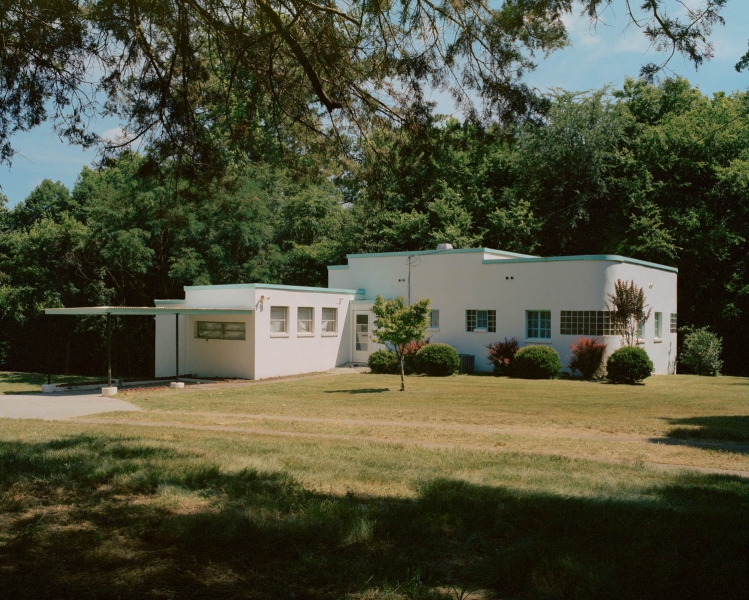Contents
Azurest South was designed by Amaza Lee Meredith and built in 1934. The home is located on the campus of Virginia State University in St. Petersburg, Virginia. Photography by Hannah Price.
It’s no secret that our country, and much of our world, has an emphatically Euro-centric view. Scores of Black architects and designers are relegated to the margins of history or forgotten entirely, never given ample credit for their significant contributions to the built environment.
At the International Interior Design Association (IIDA), we’re always seeking ways to make our industry more equitable, to make space for and celebrate designers from historically underrepresented and underappreciated groups. This Black History Month, IIDA highlighted 28 people, places, ideas, and spaces related to Black history and Black design, one for each day of February. The list is not intended to be comprehensive—the universe of Black design is vibrant and vast—but it is a joyful, often surprising, spotlight on the past, present, and future importance of Black creativity and innovation.
Below, find five of my favorite figures, spaces, and stories from our list. This is only a start; I encourage you to read the full report and keep exploring to discover more remarkable Black creatives deserving of praise and attention year-round.
Editor’s note: Executive Vice President and CEO of the IIDA, Cheryl Durst, who also happens to be an Interior Design Hall of Famer, shares her take on must-know Black creatives and their legacy in this special feature to celebrate Black History Month.
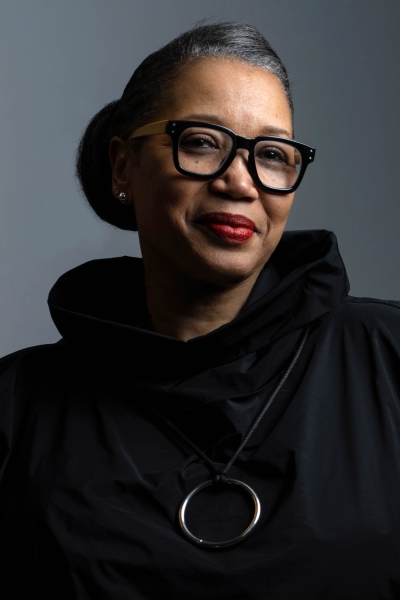
Cheryl Durst. Photography by Jason Wambsgans.
Cheryl Durst Spotlights The Legacy Of Black Creatives
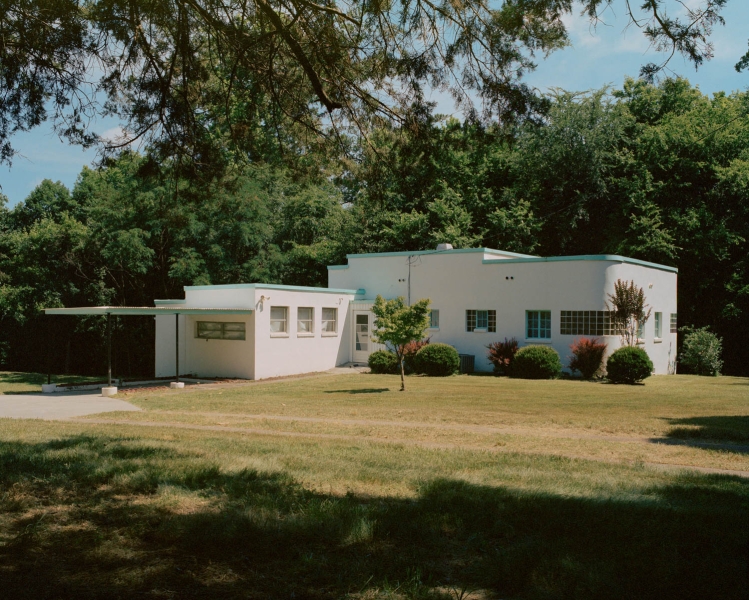
Azurest South was designed by Amaza Lee Meredith and built in 1934. The home is located on the campus of Virginia State University in St. Petersburg, Virginia. Photography by Hannah Price.
1. Harold Curtis Brown
Anyone who frequented Harlem nightclubs during the Harlem Renaissance likely enjoyed a space designed by Harold Curtis Brown. A Black, gay interior designer—a rarity for his time—Curtis shaped the interiors of then-hotspots like the Cotton Club, Tilly’s, and the Saratoga Club. Outside of Harlem, his other major projects included designing the interiors of Manhattan’s Hotel Navarro, which became an early Ritz-Carlton hotel. However, there’s much that remains unknown about Brown’s work and life—including what happened to him after 1938, when he seems to have disappeared. One architectural historian, Michael Henry Adams, believes that Brown might’ve chosen to pass as white and work under a different name to circumvent the rampant racial discrimination of the era.
2. Here: Where the Black Designers Are
Throughout her career, graphic designer, educator, and activist Cheryl D. Holmes-Miller constantly pondered one question: Where are the Black designers? In her memoir, Here: Where the Black Designers Are, she posits an answer. It’s a crisp, compellingly written look at her life in design, from her days as student at the Rhode Island School of Design, Maryland Institute College of Art, and Pratt Institute, to her work with clients like NASA, BET, and Time, Inc. In telling her story, she also recounts her efforts, and those of others, to name Black designers, because naming is powerful—it makes the invisible, visible.
“We all have a purpose in life,” Holmes-Miller writes in her book’s introduction. Her purpose? “I am called to tell you the story of the very first Black graphic designer and to make sure that the Black designer of today never goes missing again. … I lift our story to the light so that we all can see us clearly.”
3. Azurest South, Amaza Lee Meredith’s Home
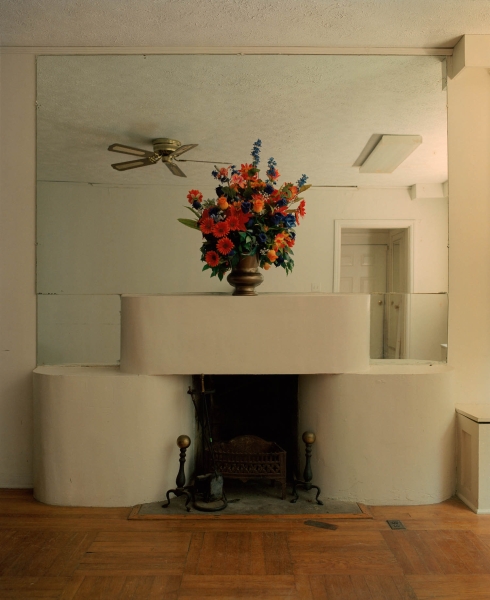
Interior of Azurest South designed by Amaza Lee Meredith, located in St. Petersburg, Virginia. Photography by Hannah Prince.
Amaza Lee Meredith was, simply put, amazing. She refused to be constrained by societal restrictions and prejudices. Born in Virginia in 1895, she became one of the country’s first Black female architects. A graduate of Virginia State University and Columbia University, Meredith chaired the art department at Virginia State and designed homes for family and friends. She designed her own home, Azurest South, in the International Style and openly lived there with her same-sex romantic partner, Dr. Edna Meade Colson. The house, which recently received grant funding for preservation efforts, is located on the Virginia State campus. Elsewhere on the East Coast, in Sag Harbor, New York, there’s more evidence of Meredith’s legacy: Azurest North, a community of summer cottages she and her sister created.
4. Norma Merrick Sklarek
The first Black woman to earn a degree in architecture from Columbia University? Norma Merrick Sklarek. The first to become a licensed architect in New York? Sklarek. In California? Again, Sklarek. (Those aren’t her only firsts; read the full story to find out more.) After college, Sklarek was rejected by 19 potential employers. That didn’t stop her. She went on to work at Skidmore, Owings, and Merrill in New York, then relocated out West for a position at Gruen Associates in Los Angeles. She ultimately rose to the role of director of architecture, and worked on projects including the Pacific Design Center, San Bernardino City Hall, and the U.S. Embassy in Tokyo.
“I think it’s absolutely impossible to understand the level of prejudice and difficulty that she faced,” Kate Diamond, who at one point co-founded an architecture firm with Sklarek, told Columbia magazine. “I’m sure she felt every one of those little cuts. But Norma … had a backbone of stainless steel. And regardless of what was happening, she would work her way through to the answer she needed to get to.”
5. The Harlem StoryMap
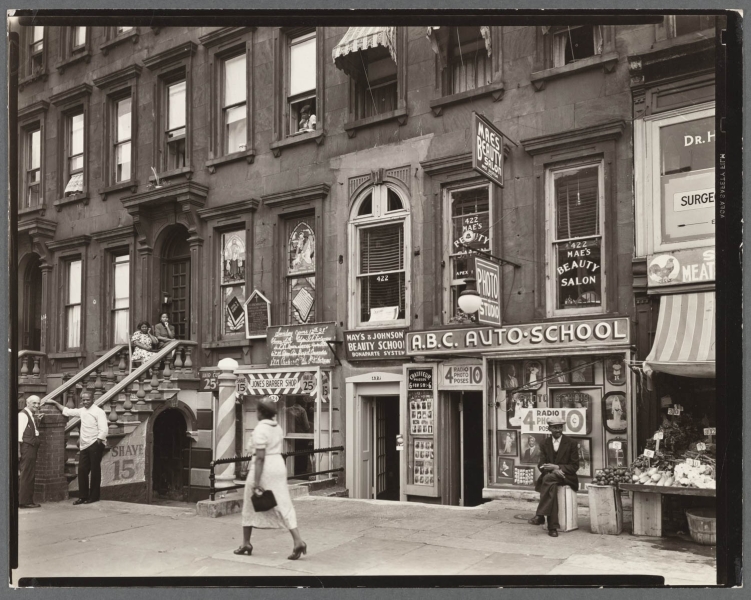
Harlem Street: II, 422-424 Lenox Avenue. A snapshot of life on Harlem’s Lenox Avenue, as photographed by Berenice Abbott in 1938. Image from The New York Public Library.
Nothing beats a good map, especially an interactive and enlightening one. The Harlem StoryMap, created in 2021 by Thandi Nyambose, a then-student at Harvard University’s Graduate School of Design, is a digital guide to Black-designed spaces across Harlem. With archival materials, census maps, and news clippings, the StoryMap is a richly textured, deeply informative look at Black Harlem. The map’s landmarks include St. Philip’s Church, designed in the early 1900s by Vertner Woodson Tandy, New York’s first Black licensed architect, and the 1937 Harlem River Houses, the city’s first federally subsidized public housing development. Designed by Black architect John Louis Wilson, the Harlem River Houses were lauded by the New York Times as a “remarkably gentle oasis.”
